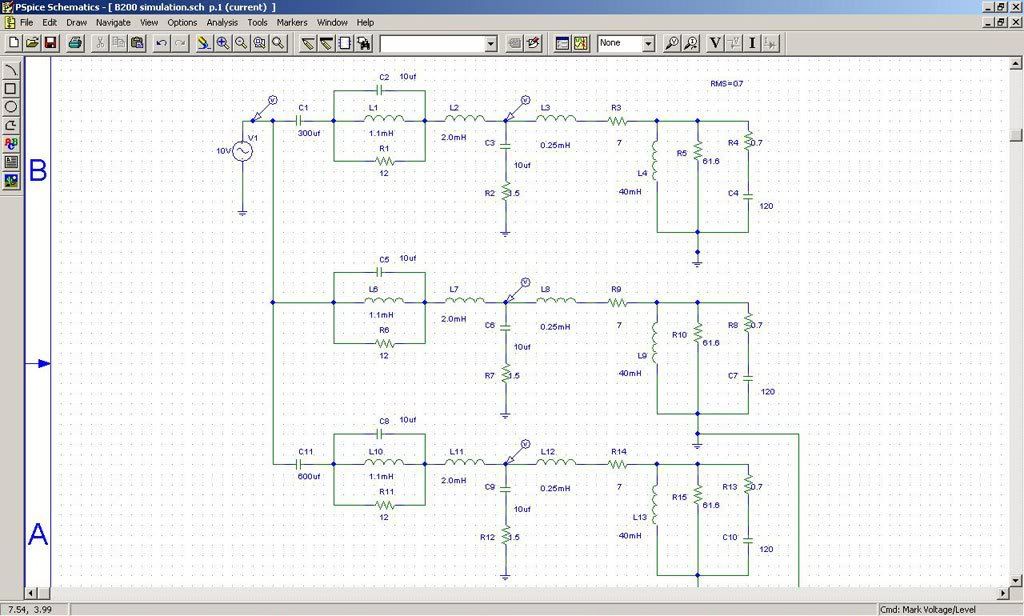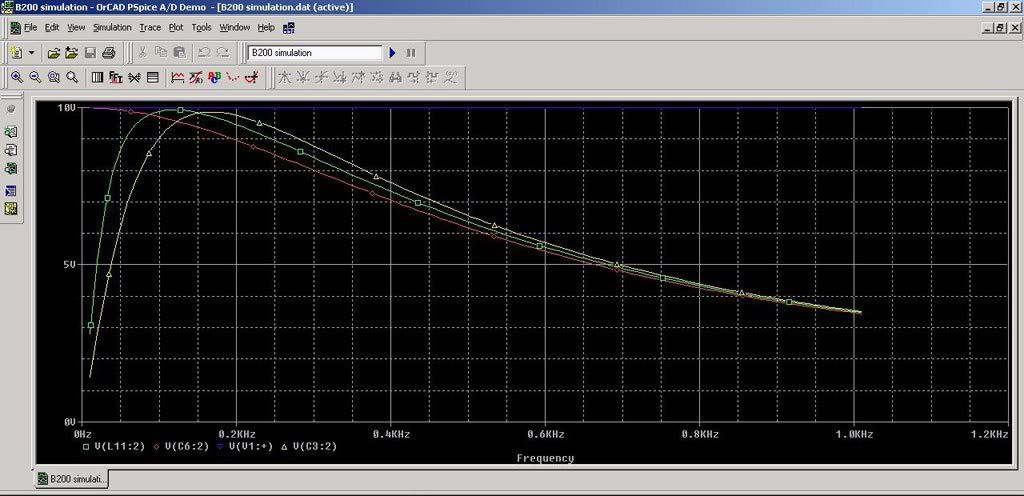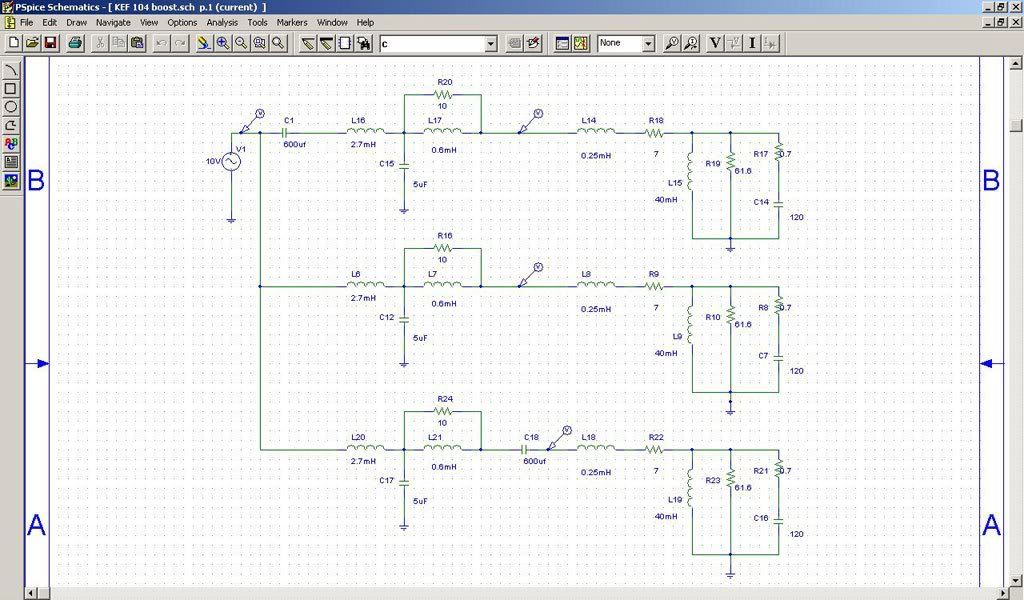| View previous topic :: View next topic |
| Author |
Message |
Nimo_jon
Intermediate Contributor 25+

Joined: 21 Feb 2011
Posts: 48
Location: Singapore
|
 Posted: Thu Mar 17, 2011 3:29 am Post subject: 600uF coupling cap in Carlton III crossover Posted: Thu Mar 17, 2011 3:29 am Post subject: 600uF coupling cap in Carlton III crossover |
 |
|
Hello
Are the 600uF capacitors in the Carlton III solely for DC blocking protection?
It appears to be a form of sonic tuning that makes the bass more mellow.
My Carlton III are fast approaching thirty over years of age.
Any suggestion on how to replace/renew the cross over network?
Cheers  |
|
| Back to top |
|
 |
ColinR
Über Contributor 1000+

Joined: 31 Jul 2004
Posts: 1175
Location: Staffordshire
|
 Posted: Thu Mar 17, 2011 10:36 am Post subject: Posted: Thu Mar 17, 2011 10:36 am Post subject: |
 |
|
| Quote: | | Are the 600uF capacitors in the Carlton III solely for DC blocking protection |
No they put a hump in the bass unit’s response near to its resonant frequency which has the effect of flattening the unit’s overall frequency response with a steeper drop off at much lower frequencies.
So you get better bass rather than extended bass, which is catered for by the ABR, neat trick eh  . .
_________________
This post or any other information supplied to this website or any other by myself is not available for any form of commercial purpose i.e. to hi-fi magazines or as sales and marketing material for sleezeBay or Audiodogging pimps and the like. |
|
| Back to top |
|
 |
Nimo_jon
Intermediate Contributor 25+

Joined: 21 Feb 2011
Posts: 48
Location: Singapore
|
 Posted: Fri Mar 18, 2011 5:21 am Post subject: Posted: Fri Mar 18, 2011 5:21 am Post subject: |
 |
|
Smart move! Thanks for the reply Colin!
Base on this fact, can I improve the quality of the bass in speakers like KEF 104, 104aB using a 600uF after the T filter, before the B200 driver?
Cheers! |
|
| Back to top |
|
 |
ColinR
Über Contributor 1000+

Joined: 31 Jul 2004
Posts: 1175
Location: Staffordshire
|
 Posted: Fri Mar 18, 2011 12:05 pm Post subject: Posted: Fri Mar 18, 2011 12:05 pm Post subject: |
 |
|
| Quote: | | can I improve the quality of the bass in speakers like KEF 104, 104aB using a 600uF after the T filter |
Dunno, unless you or a local University Acoustics Department has access to commercial design software (i.e. S.P.I.C.E.) and the types of measuring equipment used by KEF to see what can be done with a SP1039 and an ABR I think you're onto a looser.
If you could get your paws on such kit it would prove useful for seeing the effects of lower ESR and ESL (they are much shorter in length these days) in modern electrolytic capacitors.
_________________
This post or any other information supplied to this website or any other by myself is not available for any form of commercial purpose i.e. to hi-fi magazines or as sales and marketing material for sleezeBay or Audiodogging pimps and the like. |
|
| Back to top |
|
 |
Nimo_jon
Intermediate Contributor 25+

Joined: 21 Feb 2011
Posts: 48
Location: Singapore
|
 Posted: Fri Mar 18, 2011 2:04 pm Post subject: Posted: Fri Mar 18, 2011 2:04 pm Post subject: |
 |
|
Evaluations are always available FOC. 
http://zone.ni.com/devzone/cda/tut/p/id/5413
Anyone has the complete equivalent model of the B200? I can run some sim results when time allows. Good to compare with Dayton Audio OmniMic measurement. Then again, if time allows.  |
|
| Back to top |
|
 |
Nimo_jon
Intermediate Contributor 25+

Joined: 21 Feb 2011
Posts: 48
Location: Singapore
|
 Posted: Fri Mar 18, 2011 3:38 pm Post subject: Posted: Fri Mar 18, 2011 3:38 pm Post subject: |
 |
|
Alright, my years in Leicester U wasn't wasted.
The old Microsim PSPICE still works in my PC backup folder.
Here is the model of the B200 subjected to a 0-1khz freq sweep. I am comparing the Carlton III bass sections with the 600uf, without the 600uf and a 300uf.
The part that marks V is the end of the cross over, feeling the driver's equivalent circuit.

B200 electrical data may not be spot on, but for simulation and comparison the values are just approximations from the equations.
Res = Re × Qms / Qes
Ces = Qes /( 2 × p × fs × Re )
Les = Re /( 2 × p × fs × Qes)
This is the simulation result.
red trace is the frequency response without any cap.
green is frequency response with 600uF
yellow trace is frequency response with 300uF.
There are more bass boost from below 200Hz for both caps.
Now the purpose of the caps are clear.
Not really meant for DC blocking.
 |
|
| Back to top |
|
 |
ColinR
Über Contributor 1000+

Joined: 31 Jul 2004
Posts: 1175
Location: Staffordshire
|
 Posted: Fri Mar 18, 2011 3:47 pm Post subject: Posted: Fri Mar 18, 2011 3:47 pm Post subject: |
 |
|

So are you going to do a "quick and dirty" audio test by putting a fat capacitor across a SP1039 in a KEF 104 held in place by a couple of crocodile clip endowed fly leads and let us know how it sounds?
_________________
This post or any other information supplied to this website or any other by myself is not available for any form of commercial purpose i.e. to hi-fi magazines or as sales and marketing material for sleezeBay or Audiodogging pimps and the like. |
|
| Back to top |
|
 |
Nimo_jon
Intermediate Contributor 25+

Joined: 21 Feb 2011
Posts: 48
Location: Singapore
|
 Posted: Fri Mar 18, 2011 3:50 pm Post subject: Posted: Fri Mar 18, 2011 3:50 pm Post subject: |
 |
|
I Certainly am....  |
|
| Back to top |
|
 |
Nimo_jon
Intermediate Contributor 25+

Joined: 21 Feb 2011
Posts: 48
Location: Singapore
|
 Posted: Fri Mar 18, 2011 4:19 pm Post subject: Posted: Fri Mar 18, 2011 4:19 pm Post subject: |
 |
|
Ok, running simulation is always easier than putting on crocodile clips/fly leads.
Here is the 104aB bass section without a 600uf, with a 600uf before the cross over, and with a 600uf right before the driver unit.

There are bass boost below 300Hz. Putting the cap before the cross over or after has no performance difference.

I suppose putting a big cap outside the speaker box is easier........ or this will be the Nth time I open up the KEF 104  |
|
| Back to top |
|
 |
speakerguru
Über Contributor 1000+

Joined: 18 Nov 2005
Posts: 1192
Location: Green Hut, Tovil
|
 Posted: Fri Mar 18, 2011 10:36 pm Post subject: Posted: Fri Mar 18, 2011 10:36 pm Post subject: |
 |
|
| Nimo_jon wrote: | | B200 electrical data may not be spot on...... |
you can say that again   
to do a simulation, you need to have the equivalent electrical circuit of the SP1039, the SP1042, the 104 box and all the losses. It's no good getting the T-S approx parameters from the KEF data sheet. The only way is to measure the electrical impedance of the LF system, in the box, without the crossover connected and then run a optimizer on a suitable equivalent curcuit until you get a good fit. You then use that as the basis for all further modelling. Anything else is a waste of time. You might just as well switch in different Cs and listen.
BTW,don't forget, the 104/104aB is a PR system with a substantiallly 4th order roll-off. The extra C only gives you bump in the right place with a correctly aligned closed box 2nd order systems. Trying to use it with a 4th order system, will get you 5th order rolloff with more than one bump almost certainly where you don't want them. |
|
| Back to top |
|
 |
Nimo_jon
Intermediate Contributor 25+

Joined: 21 Feb 2011
Posts: 48
Location: Singapore
|
 Posted: Sat Mar 19, 2011 3:06 pm Post subject: Posted: Sat Mar 19, 2011 3:06 pm Post subject: |
 |
|
On the excitation part, I only consider the Rxo Lxo equivalent for the crossover, totally disregarding the impedance presented by the amplifier, speaker cables as well.
The driver impedance RE, LE, RLC (ES) values were derived from KEF's data sheet. I am not too concerned as this simulation was to find out the effect of the 600uf to the driver excitation. The values I used were close approximations.
I do not know how to derive the L ceb, R el, C mep for the 104 box. Certainly with all parameters fully described then can we get an accurate simulation.
However I am not a speaker designer, and I am not a fan of simulation. This is a 15 year old version student version spice to murk around. I ran some transient responses and it indicated some advantage placing the cap before the crossover. Precise simulated data are good to know but not really essential for the typical end user. Anyway, simulation is a good tool, knowing what's happening before opening up the speaker box.
I have tried out the 600uf before the 104aB low pass section. Not bad. I may switch to a 300/300uf pair NP type and try out later.
Cheers.  |
|
| Back to top |
|
 |
speakerguru
Über Contributor 1000+

Joined: 18 Nov 2005
Posts: 1192
Location: Green Hut, Tovil
|
 Posted: Sun Mar 20, 2011 12:19 pm Post subject: Posted: Sun Mar 20, 2011 12:19 pm Post subject: |
 |
|
| Nimo_jon wrote: | | I do not know how to derive the L ceb, R el, C mep for the 104 box. |
You can't derive them from any theoretical equations. You have to measure the input impedance of the system, choose an equivalent circuit and optimise the circuit until it fits the impedance you measured. If it doesn't converge, you change the circuit and go round again. Keep going until you get a good fit (better than 0.2dB over the frequency band of interest). Then you can use the optimised eq. cct. as a basis for all further simulation. It's the only way I know that works.
When I was at KEF, I spent weeks doing simulations of the 104 using an analogue simulator made up of R, L and C decade boxes and armed with a copy of Dr. Small's Ph.D.. I never did get any results I was happy with. The model was not quite good enough. When Dr. Small later came to work at KEF he developed an eq. cct optimiser which had many more options for modelling driver and box losses . I used it for modelling all the bass sections of Models 1,2,3 and 4. The results were so much more accurate than working with his previous simple models. It was like coming out of the dark ages. Coming from that background, I do so hate to see people struggling with old approximate methods which will never give good results.
BTW, why not plot amplitude on a log scale so that you can see what is happening in dB and any slope in dB/oct? |
|
| Back to top |
|
 |
Nimo_jon
Intermediate Contributor 25+

Joined: 21 Feb 2011
Posts: 48
Location: Singapore
|
 Posted: Sun Mar 20, 2011 3:14 pm Post subject: Posted: Sun Mar 20, 2011 3:14 pm Post subject: |
 |
|
Too right that deriving the correct model's a real pain.
When working on vintage speakers like the 104, there are always a few things I observe. That is, not to alter the KEF's design too much. (A novice's assumption can never be better than some experienced designers' proven work). The modification or improvement is reversible. Understand the limitations in the 70s and why certain things were done.
The 104 cabinet is not very sturdy. I know KEF had a habit of stuffing lots of sponge into the cabinet for speakers during that time. This was an effective way to make the cabinet behave much better acoustically. Right? There were times I was tempted to spray bitumen into the interior of the cabinet to strengthen it. But I did not do that because if that did not work well as an overall effect, I would be screwed big time. I tried different sponges, but in the end still not much deviation from the original arrangements. Less sponge made the speaker more lively but thinner, and more sponge made it more polite but full bodied.
Which comes to question, did KEF assert subjective assessment as part of the design/manufacturing stages? Unlike machines, we can accurately measure a certain performance parameter before it leaves the factory. But two speakers showing similar frequency response charts can sound entirely different. Who formed the panel of such subjective assessment, if there were indeed such a department in KEF? 
I have a few pairs of Carlton III in various conditions. I only have one pair of KEF 104 and one pair of 104aB, and parts enough to remake two more pairs of 104. Switching between these speakers, with a good source and a decent amplifier, I hear better bass coming from the Carlton III (its cabinet is more solid). The cabinet and cross over plays a big part of course. I am, however, not impressed with the T33s for years.
For HF, I prefer speakers with the T27 tweeters. Although some commented T27 is perky in nature and too spiky at times, it could be revealing issues in other parts of the audio chain. For example, a poor digital source or an amplifier with slew rate limitation or even a problem with the wiring in the cabinet. And personally I prefer the T27 anytime over the T33A.
What I am working now is to attempt to enable the performance of T27 on a pair of Carlton, using Seas' 22AF/G tweeter (this tweeter has an uncanny similarities with the T27 in electrical terms, and rival the sonic performance of the Hiquphon). This is another story.
I am very happy with the mid and bass of the Carlton III although it is not very deep and powerful. The T33A sound dim (even a pair of fairly new T33A constructor replacement did not help). I believe the ferro fluid has become viscous over the years, and need to be replaced. I heard that Ferro fluidic here in the Americas sell them in small packets, but this is too much trouble.
While on the 104, I would like to hear it sound more full bodied like the Carton III. So that is why I asked about the feasibility of implementing the 600uF and I am trying that out. Simple simulation only suggests what happens electrically within the crossover/driver interface.
I look at the Carlton III a continuation of the success story of the 104. (my 104s had been upgraded to newer SP1039 of late 70s. They appear to have the same cone surface finishing as those on the Cartlton III B200).
Do you think it is possible to make all of them sound similar in the end?  I don't know , but I am trying things out now. I don't know , but I am trying things out now. |
|
| Back to top |
|
 |
Nimo_jon
Intermediate Contributor 25+

Joined: 21 Feb 2011
Posts: 48
Location: Singapore
|
 Posted: Mon May 02, 2011 3:13 pm Post subject: Posted: Mon May 02, 2011 3:13 pm Post subject: |
 |
|
Hi Guys
I have tried out the 600uf in the KEF104 as well as the KEF104aB.
I suppose the SP1039 with its large magnet has sufficient bass response for most listening. The 600uf did not appear to give much advantage as in the case of the Carlton III. The 8 ohms, short coil large gap construction with a suitably damped suspension has a totally different system characteristics to that of the B200G.
The B200G SP1075 on the Carlton III has a much smaller magnet than the SP1039. It is much lighter. The suspension compliance feels totally different from that of the SP1039.
I would leave the KEF 104s as is. I have embarked on the rebuild of my KEF Calrton III, mainly due to its age and dulled tweeters. |
|
| Back to top |
|
 |
darkmatter
Junior Contributor 20+
Joined: 26 Aug 2010
Posts: 21
Location: Eastern England
|
 Posted: Sun Feb 28, 2016 8:14 pm Post subject: Posted: Sun Feb 28, 2016 8:14 pm Post subject: |
 |
|
I note that the Elektor PL301 uses a large value of series capacitance to the bass input section. IIRC
600 uF
450 uF in the CS9 kit
Wonder how much improvement could be made by fitting better quality caps noting that the size would be an important factor unless the crossovers are mounted outside of the main enclosure. |
|
| Back to top |
|
 |
|






